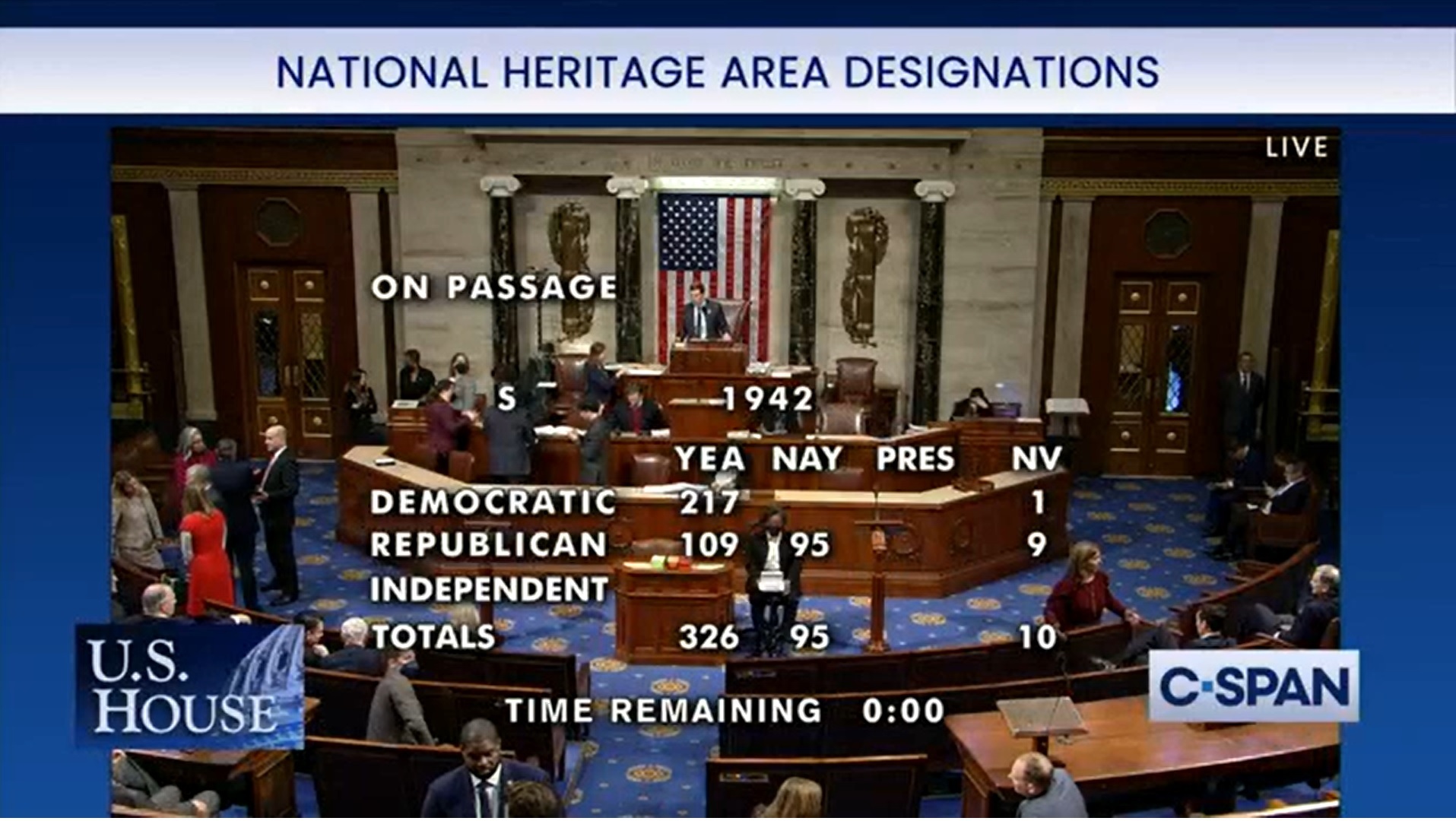

Landmark Heritage Area Legislation Becomes Law
Our history, complicated as it may be, serves as a rallying point for Americans of different backgrounds and ideologies.
This piece of legislation exemplifies what our country can do when we stand together to protect our shared legacy.~ Alan Spears, National Parks Conservation Association
National Heritage Area Act Passes Congress with Overwhelming Bipartisan Support
In the waning days of the 117th Congress, with only one remaining legislative pathway available that faced considerable odds, the National Heritage Area Act of 2022 (S. 1942) passed with wide-scale bipartisan support in the Senate and House. After decades of grassroots advocacy and unwavering support from our Congressional champions, the National Heritage Area Act received 426 favorable votes across both chambers of Congress with 100% support in the United States Senate and 77.4% in the House of Representatives. On January 5, 2023, President Joseph Biden signed the National Heritage Area Act into law (PL 117-339).

The National Heritage Area Act creates for the first time an official system of National Heritage Areas within the National Park Service, codifying the relationship between the NPS and NHAs and recognizing the effectiveness of this public-private partnership model. The law ensures long-term consistency by reauthorizing 45 National Heritage Areas for 15 years, ending the practice of short-term, year by year authorizations.
Additionally, seven new National Heritage Areas were authorized: Alabama Black Belt (AL), Bronzeville-Black Metropolis (IL), Downeast Maine (ME), Northern Neck (VA), Southern Maryland (MD), Southern Campaign of the Revolution (NC, SC), and St. Croix (USVI). A feasibility study, championed by the late Rep. McEachin for the Great Dismal Swamp NHA in Virginia was also included, as were unequivocal protections for property rights.
The Alliance of National Heritage Areas is profoundly grateful to every member of Congress and their staffs, our partners, and all the community advocates who supported the effort to enact this legislation. It is not only a demonstration of your unwavering support but a testament to the work we do in National Heritage Areas across the United States.
Support of this Act has been a long-time focus of the Coalition to Protect America’s National Parks and we are thrilled by the bill’s passage. National Heritage Areas help protect our nation’s cultural and natural resources through local conservation efforts, while also supporting recreation, education, and economic development opportunities in communities across the country.
~ Mike Murray, Chair of the Coalition to Protect America’s National Parks


National Heritage Areas support tens of thousands of jobs and contribute billions of dollars to local economies.
NHAs are catalysts for economic development in the communities in which they are located. NHAs are affiliated with the National Park Service and are managed by independent Federal Commissions, nonprofit groups, or state or municipal authorities. They implement projects through public/private partnerships with a variety of stakeholders, and collaborate with state and local governments to ensure that the regional goals of cultural, historical and natural resource protection are met. In the process, NHAs strive to improve the quality of life in their regions by fostering the development of sustainable economies.
An independent 2012 study by Tripp Umbach found that NHAs’ overall annual economic impact in the U.S. is $12.9 billion, which significantly exceeds the amount of federal funding provided to NHAs by as much as 5:1. The economic impact is comprised of three main areas: tourism, operational expenditures and grantmaking activities; the majority of impact (99%) is generated by tourism spending.
The economic impact was significant in two ways:
- $4.6 billion in direct impact, which includes tourist spending, NHA operational expenditures and grantmaking activities
- $8.3 billion in indirect and induced impacts, which includes employee spending and businesses supporting the tourism industry.
“National Heritage Areas are places where small investments pay huge dividends, providing demonstrable benefits in communities across the country and in partnership with our National Parks.” —Jon Jarvis
Read More: NHA Economic Impact Report


Independent evaluations of National Heritage Areas demonstrate strength and effectiveness of the program.
At the request of Congress, the National Park Service commissioned a series of evaluations reviewing the accomplishments of 12 of the earliest designated NHAs. These evaluations conducted by an external evaluation firm document impressive accomplishments in a limited time frame over expansive geographic areas. Generally, the evaluations reported positive findings. Each of these NHAs is meeting the goals identified in its authorizing legislation through dynamic partnerships and is leveraging its NPS funding by as much as 5:1. NPS funds were identified as the consistent and flexible seed month for projects and programs.
“The next 100 years are about renewing connections with lifelong park goers while reaching out to new audiences, from urban communities to children and teens. Inspiring a new generation of park enthusiasts is the key to building a nation that invests in its great places.” —Nextcenturyforparks.org
Key Findings:
Demonstrate Fiscal Responsibility: Every NHA met or exceeded the required match to the NPS fund. In many cases, NHAs leveraged significant investment dollars for the program and capital projects.
Preserve Nationally Significant Resources: Evaluations documented that all NHAs were conserving and interpreting cultural and natural resources of national significance.
Rely on Public Participation and Partnerships: Reports confirm that NHAs implement their management plans through partnerships with a high level of continued citizen involvement in all their work with the public.
The National Park Service is an Important Partner: NHAs received invaluable technical assistance in their programming from NPS.
Show Effective Management: Reports noted that, in general, the leaders of NHA organizations have exceptional skill in partnership development, strategic planning and longevity with their organization and have established themselves as reliable and credible partners in the communities where they work.
Provide Lessons in Working at a Landscape Scale: Many NHAs documented an increase in connectivity and understanding of the regional framework and the importance of their preservation.
